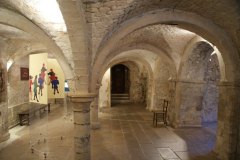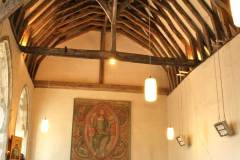The Hospital of St. Thomas the Martyr upon Eastbridge
Introduction
The Eastbridge hospital is partly constructed over the River Stour and is often overlooked in favour of the well known views of the Weavers and King’s Mill on the opposite side of the bridge.
History
After the martyrdom of St Thomas Becket in 1170, the demand from pilgrims for hospitality at the monastery & inns increased significantly and a merchant Edward FitzObold founded a hospice on Eastbridge before 1180 to meet this need. In the early 13th century the endowments were insufficient and Archbishop Walter gave the hospice tithes of some Canterbury Mills. In the same period it was combined with Hospital of St. Nicholas & Katherine nearby and the founder of this, William Cockyn, left all his wealth to combined foundation. Later in the century the adjacent houses & living of the church of St. Cosmus and St. Damian in the Blean were added to the endowments.
In the mid 14th century a further endowment of the Manor of Blean & Hoath Court was added and it from all these incomes that the foundation is sourced to this day. Later in the century the hospital needed to be reformed by Archbishop Stratford who required that 12 pilgrims to be accommodated for one day only and cared for by a woman of over forty at a cost of not more than 4 pence through the additional endowment of a Chantry at Bekesbourne. A grant bearing the seal of Archbishop Sudbury allowing residents to be buried in Cathedral is contained in a case in Refectory from the end of this century. From the beginning of the 15C the Master was Prebendary (present day Canon) or other appointee of the Archbishop and and subsequently many relations of Archbishops took the post.
At the Reformation in mid 16C pilgrimage stopped and hospital fell into ruin, to be rescued by Archbishop Parker who revived the original foundation, only this time for the vagrant poor. He added a school (probably where Christopher Marlowe was initially educated) for twenty boys in the chapel, which continued to mid the 19th century. After further abuse it was rescued again in 1584 by Archbishop Whitgift, who initiated the custom of the Mayor of the City of Canterbury nominating two deserving people to reside in the hospital. They were to have lived in the city for at least seven years and lived in the houses for six men in main building and six women built behind the refectory. This building can be seen in a print from the 18th century (Image 1). In the 19th century the hospital was linked to several now disappeared city churches but from 1927 has been associated with St. Peter’s. During 20th century much restoration work has been undertaken, partly funded by the sale of some land in the Manor of Blean for the creation of the University of Kent.
What to see:
- The front of mid 14th century knapped flint containing three early perpendicular two light windows to the 1st floor chapel and a gothic entrance door set in Norman arch down steps due to the raising of road in c. 1190 (Image 2).
- The refectory undercroft of transitional Gothic of c. 1190, originally a dormitory with two beds per cubicle (Image 4).
- The chapel of Our Lady of the mid 13th century (Image 5).
- The rare 13th century king strut and scissor braced roof of the chapel supporting an octagonal spirelet on a tie beam (Image 6).
- The refectory hall containing a 20th century minstrel’s gallery (Image 7) and a 14th century mural of Christ in Glory (Image 8).
- The adjacent Masters Lodge (Image 9).
- The unusual arms of Archbishop Juxon on the external wall (Image 10).
Update as of September 2023: CHAS understands that Eastbridge Hospital is closed to visitors until Easter 2024 while urgent structural repairs take place. However the gardens are currently open most days.
Sources: Ingram Hill (2004); Newman(1983)
SR










